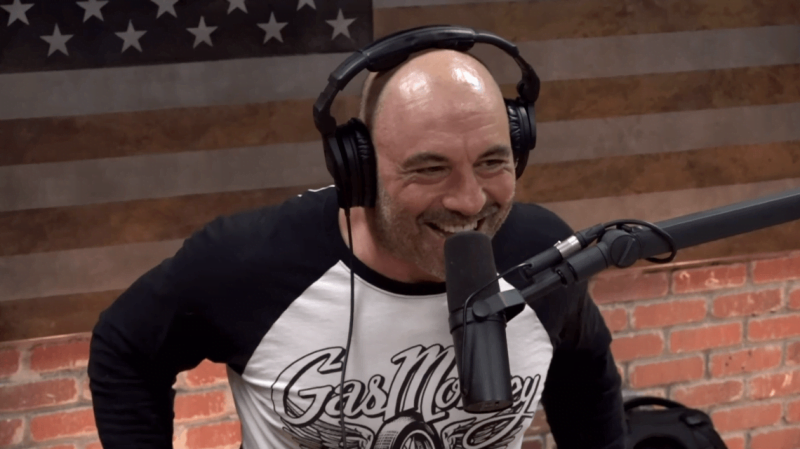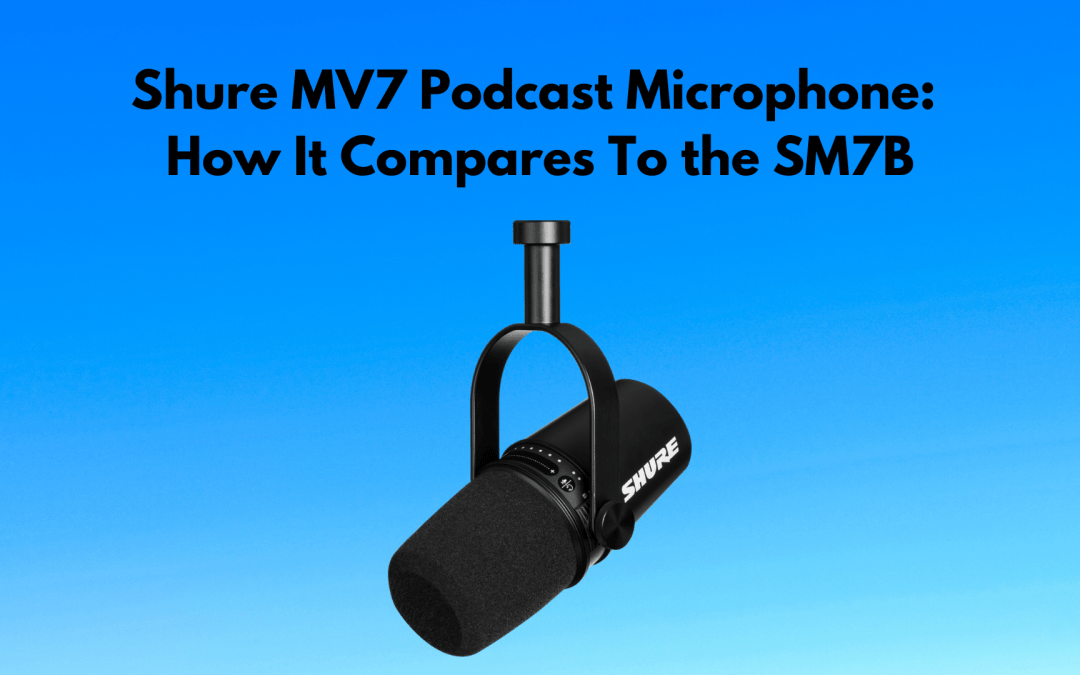For many years, Shure’s SM7B microphone has been a mainstay in the broadcast industry. You may not have seen them, but you’ve certainly heard them. The SM7B has made a home for itself in many music recording studios, too. If the SM7B is so perfect, then why has the Shure MV7 podcast microphone been created as well?

Joe Rogan uses Shure SM7B microphones on his podcast
It’s no surprise that legendary microphones such as the Shure SM7B and Electro-Voice RE20 have also been welcomed into the podcasting space. They are, however, outside the price range of many hobbyists. As well, these traditional microphones require an XLR connection. This means an audio interface is needed, increasing the cost and complexity of a setup.
Simplicity and affordability are why microphones like the Blue Yeti USB and Audio Technica ATR2100x rose in popularity among podcasters.
Shure is one of the biggest microphone companies in the world. They’re a little late to this party, but it was worth the wait. Enter the MV7. Shure is now (sort of) offering that legendary SM7B microphone sound in a USB version. We say “sort of” because Shure uses the wording that the MV7 is “inspired by” the SM7B. As we’ll find out, there are differences between the two.

Shure MV7 Microphone
XLR & USB in One
Not only does the MV7 have a USB connection, but XLR as well! This puts it in the relatively uncrowded space with other versatile USB/XLR microphones like the Samson SAM-Q2U and Audio Technica ATR2100x.
Combination USB/XLR microphones give the ultimate flexibility. Since USB microphones must be used on their own, they’re perfect for single speakers recording a solo podcast or online interview. If you want to record in a multi-microphone setup, you’d need XLR microphones. Purchasing a microphone with both connections means you can use it in a variety of ways and never worry about outgrowing it.

You could use the MV7 as part of a multi-mic podcast setup at home, but take it on the road to record sales videos from a hotel room. It’s also great if you start out as a solo podcaster but later develop a bigger studio or have additional people join your podcast.
MV7 vs SM7B
Creating a USB version of the SM7B would have been cool on its own, but getting the XLR connection in there increases the value of this microphone in a big way. The SM7B traditionally sells for $399 USD, while the MV7 comes in at $249.
You may be wondering: what’s the catch? Are you really getting that sought-after SM7B sound, with an added USB connection, for less money?
The short answer is no.
Shure has an article comparing the two microphones in which they clearly state some of the differences. This includes that the MV7 “emphasizes the midrange frequencies, where the clarity and intelligibility of speech lives” while the SM7B “has significantly more low-end, which is where that signature broadcast sound comes from.”
We found this a bit surprising. The SM7B’s signature sound is what made that microphone so sought-after in the first place. Why release an “inspired by” version but change the sound?
Shure continues, saying that the MV7 “won’t replace the legendary SM7B – but it certainly makes a great addition to the family.”
Perhaps it was a cost issue. Maybe Shure just felt this would sell better as a speech-optimized microphone and wanted to capitalize on the recognition of the SM7B. Whatever the case, we trust Shure knows what they’re doing. There are also a variety of settings that can give the microphone more resemblance of the darker SM7B sound. Take a listen to a comparison in the video below.
Other MV7 Advantages
Shure didn’t stop at just a USB connection. The MV7 packs even more cool features!
Most notably, the ShurePlus™ MOTIV app which includes settings to optimize for vocal tone, distance from microphone, auto level mode, and more.
If you edit your podcast recordings in a DAW, or send them to a professional editor, we recommend disabling all of these settings. However, for cases like live video calls or recording screenshares, we love that these settings can be easily used on the fly with no post-production or finagling needed. If you skip earlier in the above video, you can hear a demo of the app’s settings. You don’t need to be an audio engineer, as Shure has made the controls simple for anybody to use.
Shure MV7 Cons
The Shure MV7 isn’t perfect. While overall reviews are positive, there are a few negative remarks that come up.
These include:
- Its pop filter is flimsy compared to the SM7B’s, and plosives develop when talking directly into the mic
- Gain had to be turned very high
- Micro-USB port is dated and a little flimsy
- No stand included
Shure MV7 Podcast Microphone Summary
Overall, we like this microphone. The price is reasonable and it sounds great. We are big fans of combination USB/XLR microphones for optimal versatility and room for future growth.
In terms of value, there are better options, but it all depends on your specific needs.
The Blue Yeti is about half the cost, includes a built-in stand, and has multiple pickup-patterns which are useful for when multiple people must share the microphone. Conversely, the Yeti does not have an XLR output and its audio quality is arguably not as good as the MV7’s.
The Shure MV7 podcast microphone retails for $249 USD and is available in black or silver. No stand is included, so if you don’t have something already, be sure to pick up a sturdy stand or boom arm.
Since some users complained about the lousy pop filter, you may want to add something extra.
Shure has tons of details and further info on their MV7 page and YouTube channel.
MV7+ Update
In early 2024, Shure released an updated version of the MV7. While it doesn’t really justify upgrading from the MV7, it offers some fresh features like a USB-C connection and more futuristic signal meter. Take a look at the MV7+ on Amazon.
Want professional help to ensure your podcast sounds amazing? Get in touch with us today!
This article contains affiliate links and we may share a portion of the sale should you click through and make a purchase. We are not affiliated with Shure, nor were we paid, bribed, or given any free products to write this article. But that’s not to say we’re not interested.


